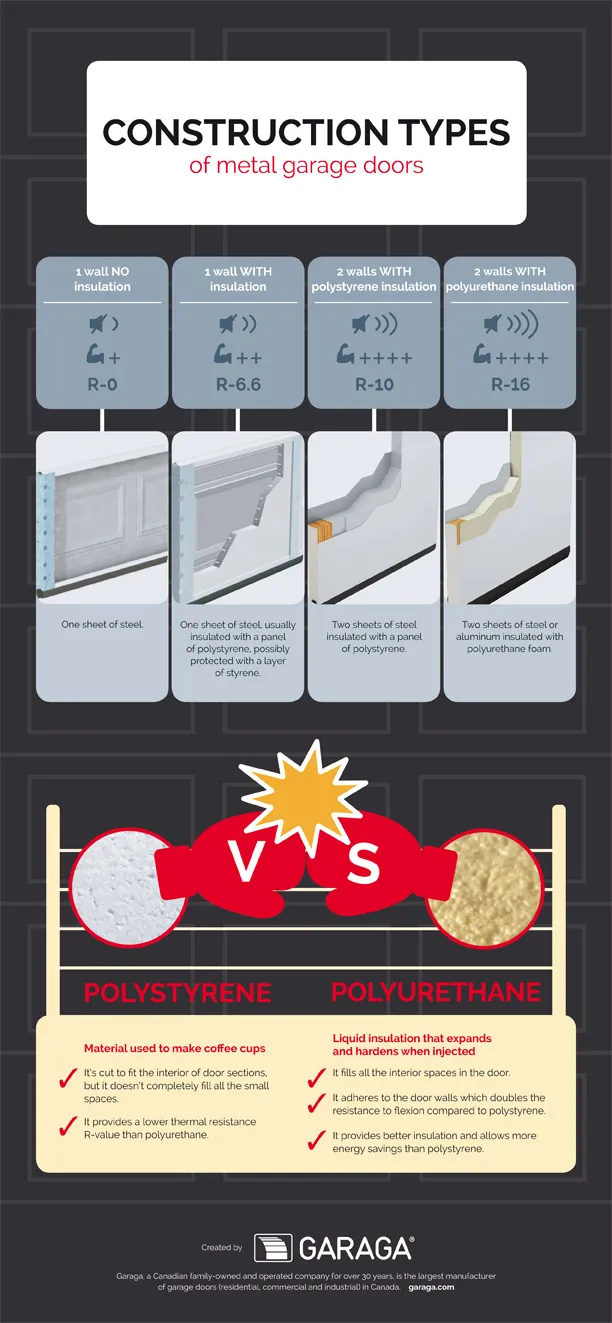Insulated or non-insulated… what’s the difference? Most of the garage doors available on the market are made of galvanized steel. Others are made from aluminum panels (with insulation) or from fully glazed aluminum extrusions They are available in thicknesses ranging from 1 to 2 inches, with or without insulation. Here’s some basic information to guide you!
One, two or three-layers: what does it mean?
1 and 2-layer:
- Non-insulated garage doors are made from a single sheet of molded steel and are usually 2” thick to lend a certain amount of solidity to the structure of the panel (section).
- Garage door manufacturers offer an optional panel of Styrofoam insulation, covered with a sheet of rigid styrene to prevent the insulation from catching on fire.
3-layers:
- These garage doors are made from steel sheets with insulation between them. The insulation is usually made from Styrofoam or polyurethane.
- The doors with Styrofoam insulation come in thicknesses of 1⅜”, 1¾” or 2” (35 to 51 mm).
- The doors with polyurethane insulation have a thickness between 1⅜” and 2” (35 and 51 mm). The vast majority of these doors are 1⅝” or 1¾” (41 or 45 mm) thick.
Polystyrene or polyurethane: which is better?
It all depends on what you’re looking for. First of all, let’s define the two types of insulation:
Polystyrene:
- Commonly known as Styrofoam, it’s used to make coffee cups and protective packing material for appliances and other merchandise.
- It’s expanded: heat is used to expand tiny beads of polystyrene foam in a precise mold. Once the block is removed from the mold, it is cut to the desired size and shape
- In terms of insulation, it’s less effective than polyurethane. Inch-for-inch, polyurethane is twice as effective as polystyrene.
Polyurethane:
- This is a chemical composite of several products, which once mixed together can swell to fill up just about any space. This mixture forms closed cells, which lend it high thermal resistance.
- Polyurethane is found in all kinds of different things: the foam is used to make chairs and even bumpers for motor vehicles. It’s all a simple matter of the density of the foam. The higher the density, the more rigid the insulation. Since garage doors vary from 8’ to 18’ (2.4 to 5.5 m) in length, it’s necessary to find insulation of the correct density to ensure the right thermal resistance factor and the ideal rigidity in the construction of the panel (section).
- It is also used in front doors, which are 1¾” (45 mm) thick.
Are there any other factors that might influence my decision?
Yes, there are at least two more: durability and soundproofing.
Durability:
- This is also called tensile strength (the amount of pressure that can be applied to the middle of the panel before it breaks). This measurement is especially useful in places where your garage door may be exposed to strong winds or if you leave it open for extended periods (e.g. an entire day).
- Since polyurethane sticks to the walls of the door, it offers twice the resistance of a door of the same thickness insulated with a Styrofoam panel.
- Is an uninsulated door that’s 2” (51 mm) thick a lot less durable than a 1¾” (51 mm) door with polyurethane foam? Yes, by at least 122%.
- • Don’t kid yourself. If you crash into your garage door at 15 km/h (9 mph), you will definitely do significant damage to it.
Soundproofing:
- It’s easy to understand why an uninsulated door would be less soundproof than a door of the same thickness that’s insulated, especially if it has polyurethane insulation.
- A non-insulated door is perfectly fine for an unheated garage (or shed). However, if your garage is attached to your home and you want to muffle outside noise, a door with polyurethane foam insulation would be your best bet.
Contact a garage door specialist in your area. He or she will be happy to give you advice on the best choice, based on your budget and how you use your garage door. The specialist will give you a detailed explanation of all the different garage door models available on the market and will use samples to demonstrate how each one is constructed.


Comments
Porte garage vitrée
Si je veut faire un appartement dans mon garage Puis-je utiliser une porte de garage vitrée où l’on peut voir à l’extérieur sans que les gens voit a l’intérieur et qui sera bien isolée ?
Garaga
Bonjour Madame Leblanc, quel beau projet que vous avez! Nous vous recommandons de contacter un détaillant afin d'obtenir une réponse plus détaillée selon votre situation précise. Vous pouvez trouver un détaillant ici : https://www.garaga.com/fr-ca/trouvez-votre-detaillant-garaga
Add new comment